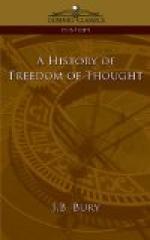Under Constantine the Great and his successors, edict after edict fulminated against the worship of the old pagan gods and against heretical Christian sects. Julian the Apostate, who in his brief reign (A.D. 361-3) sought to revive the old order of things, proclaimed universal toleration, but he placed Christians at a disadvantage by forbidding them to teach in schools. This was only a momentary check. Paganism was finally shattered by the severe laws of Theodosius I (end of fourth century). It lingered on here and there for more than another century, especially at Rome and Athens, but had little importance. The Christians were more concerned in striving among themselves than in
[55] crushing the prostrate spirit of antiquity. The execution of the heretic Priscillian in Spain (fourth century) inaugurated the punishment of heresy by death. It is interesting to see a non-Christian of this age teaching the Christian sects that they should suffer one another. Themistius in an address to the Emperor Valens urged him to repeal his edicts against the Christians with whom he did not agree, and expounded a theory of toleration. “The religious beliefs of individuals are a field in which the authority of a government cannot be effective; compliance can only lead to hypocritical professions. Every faith should be allowed; the civil government should govern orthodox and heterodox to the common good. God himself plainly shows that he wishes various forms of worship; there are many roads by which one can reach him.”
No father of the Church has been more esteemed or enjoyed higher authority than St. Augustine (died A.D. 410). He formulated the principle of persecution for the guidance of future generations, basing it on the firm foundation of Scripture—on words used by Jesus Christ in one of his parables, “Compel them to come in.” Till the end of the twelfth century the Church worked hard to suppress heterodoxies. There was much
[56] persecution, but it was not systematic. There is reason to think that in the pursuit of heresy the Church was mainly guided by considerations of its temporal interest, and was roused to severe action only when the spread of false doctrine threatened to reduce its revenues or seemed a menace to society. At the end of the twelfth century Innocent III became Pope and under him the Church of Western Europe reached the height of its power. He and his immediate successors are responsible for imagining and beginning an organized movement to sweep heretics out of Christendom. Languedoc in Southwestern France was largely populated by heretics, whose opinions were considered particularly offensive, known as the Albigeois. They were the subjects of the Count of Toulouse, and were an industrious and respectable people. But the Church got far too little money out of this anti-clerical population, and Innocent called upon the Count to extirpate heresy from his dominion. As he would not obey, the Pope announced a Crusade against the Albigeois, and offered to all who would bear a hand the usual rewards granted to Crusaders, including absolution from all their sins. A series of sanguinary wars followed in which the Englishman, Simon de Montfort, took part. There were




